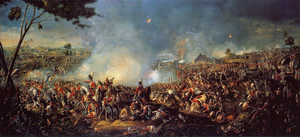ยุทธการที่วอเตอร์ลู
| ยุทธการที่วอเตอร์ลู | |||||||
|---|---|---|---|---|---|---|---|
| ส่วนหนึ่งของ การทัพวอเตอร์ลู | |||||||
 ยุทธการที่วอเตอร์ลู โดยวิลเลียม แซดเลอร์ที่ 2 | |||||||
| |||||||
| คู่สงคราม | |||||||
|
| |||||||
| ผู้บังคับบัญชาและผู้นำ | |||||||
|
|
| ||||||
| กำลัง | |||||||
|
รวม: 118,000-120,000 นาย[1]
กองทัพบลึชเชอร์:
| ||||||
| ความสูญเสีย | |||||||
|
รวม: 41,000-42,000 นาย[1] |
รวม: 23,000[1]-24,000 นาย
กองทัพบลึชเชอร์: 7,000 นาย
| ||||||
| ทั้งสองฝั่ง: ม้าถูกฆ่า 7,000 ตัว | |||||||
ยุทธการที่วอเตอร์ลู (อังกฤษ: Battle of Waterloo) เกิดขึ้นเมื่อ 18 มิถุนายน ค.ศ. 1815 ที่หมู่บ้านวอเตอร์ลู ประเทศเบลเยียม (ส่วนหนึ่งของสหราชอาณาจักรเนเธอร์แลนด์) กองทัพฝรั่งเศสในบัญชาของจักรพรรดินโปเลียนพ่ายแพ้ต่อสองกองทัพฝ่ายสหสัมพันธมิตร กองทัพแรกคือทัพผสมระหว่างบริเตน, เนเธอร์แลนด์, ฮันโนเฟอร์, เบราน์ชไวค์ และนัสเซา ในบัญชาของจอมพลดยุกแห่งเวลลิงตัน กองทัพที่สองคือทัพปรัสเซียในบัญชาของจอมพลเก็พฮาร์ท ฟ็อน บลึชเชอร์ ยุทธการครั้งนี้เป็นจุดจบของสงครามนโปเลียน ยุทธการนี้มีชื่อเรียกในสมัยนั้นว่า ยุทธการที่มงแซ็ง-ฌ็อง (ฝรั่งเศส) หรือ พันธมิตรอันงดงาม (ปรัสเซีย)[11]
เมื่อนโปเลียนหนีออกจากเกาะเอลบาและคืนสู่อำนาจในเดือนมีนาคม ค.ศ. 1815 ประเทศทั้งหลายรีบตัวกันจัดตั้งกองทัพสหสัมพันธมิตรเพื่อต่อต้านนโปเลียน กองทัพเวลลิงตันและกองทัพบลึชเชอร์ตั้งค่ายอยู่ใกล้ชายแดนทางเหนือของฝรั่งเศส นโปเลียนวางแผนทั้งคู่ก่อนที่ทั้งคู่จะรวมตัวกับกองทัพพันธมิตรอื่นและบุกเข้าฝรั่งเศส ในวันที่ 16 มิถุนายน นโปเลียนประสบความสำเร็จในการรุกตีกองทัพปรัสเซียในยุทธการที่ลิงงี (Ligny) ด้วยกองหลัก ทำให้ปรัสเซียต้องถอยร่นขึ้นเหนือในวันต่อมา แต่ศึกด้านเวลลิงตันจบลงที่ผลเสมอ นโปเลียนส่งกำลังราวหนึ่งในสามเพื่อไล่ตีกองทัพปรัสเซียจนเกิดเป็นยุทธการที่วาฟ (Wavre) เมื่อวันที่ 18–19 มิถุนายน ทำให้ทหารฝรั่งเศสหน่วยดังกล่าวอยู่ในภาวะรบติดพันและมาที่วอเตอร์ลูไม่ได้
ดยุกแห่งเวลลิงตันทราบเรื่องดังกล่าวและมองเห็นเป็นโอกาสดี เขาตัดสินใจตั้งทัพที่เนินมงแซ็งฌ็อง (Mont-Saint-Jean)[12] บนทางหลวงเชื่อมบรัสเซลส์ ใกล้หมู่บ้านวอเตอร์ลู เวลลิงตันรับการโจมตีอย่างต่อเนื่องของฝรั่งเศสตลอดบ่าย 18 มิถุนายน เมื่อทหารปรัสเซียมาถึง กองทัพปรัสเซียเข้าตีปีกข้างของกองทัพฝรั่งเศสและสร้างความเสียหายอย่างมาก เมื่อตกค่ำ นโปเลียนสั่งทหารราบรักษาพระองค์ (Garde Impériale) ซึ่งเป็นกองหนุนหน่วยสุดท้ายที่เหลืออยู่เข้าโจมตีแถวทหารอังกฤษ อีกด้านหนึ่ง ทหารปรัสเซียรุกฝ่าเข้ามาทางปีกขวาของกองทัพฝรั่งเศส ทหารอังกฤษสามารถยันกองพันทหารราบฝรั่งเศสไว้ได้ กองทัพฝรั่งเศสแพ้ราบคาบ
วอเตอร์ลูเป็นการสู้รบที่เด็ดขาดในการทัพวอเตอร์ลูและเป็นการสู้รบครั้งสุดท้ายของนโปเลียน นโปเลียนสละราชสมบัติในอีกสี่วันให้หลัง กองทัพผสมเคลื่อนพลเข้าสู่กรุงปารีสในวันที่ 7 กรกฎาคม ความพ่ายแพ้ที่วอเตอร์ลูปิดฉากการปกครองของนโปเลียนในฐานะจักรพรรดิฝรั่งเศส เป็นจุดจบของสมัยร้อยวัน และเป็นจุดสิ้นสุดของจักรวรรดิฝรั่งเศสที่ 1 สนามรบตั้งอยู่ในเทศบาลเบรนลาเลอ (Braine-l'Alleud) และลาน (Lasne) ของประเทศเบลเยียม[13] ตั้งอยู่ทางใต้ของบรัสเซลล์ประมาณ 15 กิโลเมตร (9.3 ไมล์) และจากเมืองวอเตอร์ลูประมาณ 2 กิโลเมตร (1.2 ไมล์) บริเวณที่เป็นอดีตสนามรบ ปัจจุบันกลายเป็นอนุสรณ์เนินดินเทียมที่สร้างขึ้นจากดินในยุทธบริเวณ ส่วนภูมิประเทศของสนามรบใกล้เนินดินไม่ได้รับการอนุรักษ์ไว้
ภูมิหลัง[แก้]
นโปเลียนหลบหนีออกจากเกาะเอลบาเมื่อวันที่ 26 กุมภาพันธ์ ค.ศ. 1815 ขณะนั้น ประเทศมหาอำนาจอยู่ระหว่างการประชุมใหญ่แห่งเวียนนาเพื่อจัดระเบียบทวีปยุโรป เมื่อที่ประชุมรับทราบข่าวการหลบหนีของนโปเลียน จึงประกาศให้นโปเลียนเป็นบุคคลนอกกฎหมายในวันที่ 13 มีนาคม และในอีกสี่วันต่อมา กองทัพของสหราชอาณาจักร, รัสเซีย, ออสเตรีย และปรัสเซีย เริ่มเคลื่อนกำลังเพื่อล้มล้างนโปเลียน[14] และเนื่องจากกองทัพข้าศึกมีจำนวนในภาพรวมเหนือกว่าอย่างขาดลอย นโปเลียนจึงทราบดีว่าโอกาสเดียวของเขาคือการชิงโจมตีก่อนที่กองทัพข้าศึกจะสนธิกำลังเป็นกองทัพขนาดใหญ่[15]
ถ้าหากนโปเลียนทำลายกองทัพข้าศึกที่อยู่ทางใต้ของกรุงบรัสเซลล์ก่อนที่ข้าศึกจะได้รับกำลังเสริม เขาก็อาจจะสามารถผลักดันกองทัพอังกฤษกลับไปยังชายฝั่งมหาสมุทร และเอาชนะกองทัพปรัสเซีย สถานการณ์นี้จะช่วยให้เขามีเวลาฝึกฝนกำลังพลและจัดเตรียมกองทัพให้พร้อมรบกับกองทัพผสมของออสเตรีย-รัสเซีย[16][17] นอกจากนี้ ถ้าหากนโปเลียนได้รับชัยชนะในศึกนี้ ก็อาจจะเป็นแรงผลักดันให้ประชากรเบลเยียมที่พูดภาษาฝรั่งเศส ก่อการปฏิวัติขึ้นในประเทศเบลเยียม ซึ่งก็จะส่งผลดีต่อเขาเช่นกัน ไม่เท่านั้น กำลังทหารข้าศึกในเบลเยียมก็ไม่ใช่ทหารชั้นดี เนื่องจากหน่วยทหารชั้นดีมากประสบการณ์ถูกส่งไปทวีปอเมริกาเหนือเพื่อร่วมรบในสงคราม ค.ศ. 1812[15]

ทางด้านแม่ทัพอังกฤษอย่างจอมพลดยุกแห่งเวลลิงตัน ในตอนแรกวางแผนจะรับมือภัยคุกคามจากนโปเลียนโดยการเคลื่อนกำลังผ่านเมืองมงส์ (Mons) ไปยังตะวันตกเฉียงใต้ของกรุงบรัสเซลล์[18] การกระทำนี้มีข้อดีคือจะทำให้กองทัพของเวลลิงตันอยู่ในตำแหน่งที่ใกล้ชิดยิ่งขึ้นกับกองทัพปรัสเซียในบัญชาของจอมพลบลึชเชอร์ แต่ก็มีข้อเสียคืออาจจะทำให้สูญเสียการติดต่อกับฐานทัพอังกฤษที่เมืองโอสต็องด์ (Ostend) ซึ่งตั้งอยู่ติดชายฝั่งช่องแคบอังกฤษ นโปเลียนชะลอการเคลื่อนกำลังของจอมพลเวลลิงตัน โดยการปล่อยข่าวเท็จเพื่อลวงว่าฝรั่งเศสตัดสายส่งกำลังจากช่องแคบอังกฤษถึงกองทัพของเวลลิงตัน[19]
นโปเลียนเคยมีสรรพกำลังถึงประมาณสามแสนนายในเดือนมิถุนายน แต่บัดนี้เขามีกำลังที่วอเตอร์ลูมีไม่ถึงหนึ่งในสามของจำนวนที่ว่า กระนั้น กำลังพลเกือบทั้งหมดก็เป็นทหารชาญศึกที่มีความจงรักภักดียิ่ง[20] นโปเลียนแบ่งกำลังออกเป็นสามส่วน ได้แก่ปีกซ้ายในบัญชาของจอมพลมีแชล แน, ปีกขวาในบัญชาของจอมพลแอมานุแอล เดอ กรูชี และกำลังสำรองซึ่งบัญชาโดยตัวพระองค์เอง กองทัพฝรั่งเศสข้ามเส้นเขตแดนใกล้กลับเมืองชาร์เลอรัว (Charleroi) ภายในเช้าวันที่ 15 มิถุนายน และรีบบุกครองชัยภูมิสำคัญ ทำให้นโปเลียนอยู่ในตำแหน่งตรงกลางระหว่างกองทัพเวลลิงตันกับกองทัพบลึชเชอร์ เพื่อยับยั้งไม่ให้สองทัพข้าศึกทำการสนธิกำลัง นโปเลียนตั้งใจจะทำลายกองทัพบลึชเชอร์เสียก่อน แล้วจึงทำลายกองทัพเวลลิงตัน[21][22][23][24]
ในคืนวันที่ 15 มิถุนายน ดยุกแห่งเวลลิงตันแน่ใจแล้วว่าหน่วยทหารที่รุกขึ้นเหนือมายังชาเลอรัวเป็นกำลังหลักข้าศึก ในเช้าของวันที่ 15 มิถุนายน จอมพลเจ้าชายแห่งออเรนจ์ทำการส่งกำลังส่วนแยกมาให้แก่ดยุกแห่งเวลลิงตัน แต่แล้วเวลลิงตันก็ต้องตกใจกับความเร็วการรุกของนโปเลียน ดยุกแห่งเวลลิงตันจึงรีบสั่งการให้รวมกำลังไว้ที่หมู่บ้านกาทร์บรา (Quatre Bras) สิบเก้ากิโลเมตรทางเหนือของชาเลอรัว อันเป็นตำแหน่งที่เจ้าชายแห่งออเรนจ์และเจ้าชายแบร์นฮาร์ดแห่งซัคเซิน-ไวมาร์ตั้งทัพอยู่ ตำแหน่งดังกล่าวแทบไม่มีผลดีในการต่อต้านปีกซ้ายของจอมพลแน[25]
การรบ[แก้]

สมรภูมิวอเตอร์ลูมีแนวสันเขาตามทิศตะวันตกไปทิศตะวันออก มีถนนไปบรัสเซล์ตัดผ่านตรงกลางในแนวตั้งฉาก ทางยอดเขามีถนนโออังและหุบเหวตื้น ที่จุดตัดของถนนไปบรัสเซล์มีต้นเอม ซึ่งเวลลิงตันได้ควบคุมการรบที่นั่น โดยใช้การรบบนเนินเขา[26]ความยาวของกองทัพนั้นประมาณ 2.5 ไมล์ (4.0 กิโลเมตร) เวลลิงตันจึงสามารถนำกองทัพของเขารุกขึ้นมาได้ ซึ่งเขาทำในช่วงตอนกลางและฝั่งขวาไปยังหมู่บ้านแบรน์-ลาลเลอดโดยหวังใช้กองทัพปรัสเซียมาถึงให้ทันเวลา[27] ด้านหน้าสันเขามีจุดสำตัญที่สามารถใช้ป้องกันการโจมตีได้ ฝั่งขวาสุดมีชาโต สวน และสวมผลไม้ที่อูโกมองต์มีบ้านที่ซ่อนอยู่ท่ามกลางต้นไม้ซึ่งหันไปทางทิศเหนือ ตามแนวร่องเหว ฝั่งซ้ายสุดมีหมู่บ้านเล็กๆ ชื่อปาปล็อต(Papelotte) ซึ่งอูโกมองต์และปาปล็อตได้มีทหารประจำการ ซึ่งทำให้การโจมตีตามแนวขอบใช้ไม่ได้ และปาปล็อตยังยึดถนนไปวาเวรอ ซึ่งทหารปรัสเซียใช้เดินทางมา ทิศตะวันตกของถนนไปบรัสเซล์มีฟาร์มชื่อว่าลาแอย์แซงต์มีทหารเบาแห่งกองทหารแห่งกษัตริย์เยอรมัน 400 นายประจำการอยู่.[28] ด้านตรงข้ามของถนนมีเหมืองทราย ที่หน่วยไรเฟิลที่ 95ประจำการเป็นพลแม่นปืน[29] ตำแหน่งของกองทัพเช่นนี้เป็นสิ่งที่ลำบากใจในการโจมตี การโจมตีต้องโจมตีที่อูโกมง ถ้าโจมตีตรงกลางจะถูงยิงทั้งสองด้าน คือทางอูโกมงและลาแอย์แซงต์ ฝั่งซ้ายจะถูกโจมตีที่ลาแอย์แซงต์ และเมืองปาปล็อต [30] กองทัพฝรั่งเศสอยู่ทางใต้ของสันเขา นโปเลียนไม่เห็นตำแหน่งของเวลลิงตัน จึงเดินทัพไปทางถนนบรัสเซล ปีกขวามีกองที่ 1 นำทัพโดยเดอลงมีทหารราบ 1,600 นาย ทหารม้า 1,500 นาย และสำรองอีก 4,700 ปีกซ้ายนำโดยรายยี มีทหารราบ 1,300 นาย ทหารม้า 1,300 นายและสำรองอีก 4,600 นาย ตรงกลางถนนไปยังลา แบล อาลายยังมีกำลังเสริมของโลโบ ประกอบด้วยทหารราบ 6,000 ทหารรักษาพระองค์ 1,300 นาย และทหารท้าอีก 1,200 นาย[31]
อ้างอิง[แก้]
- ↑ 1.0 1.1 1.2 1.3 1.4 Bodart 1908, p. 487.
- ↑ Hofschröer 1999, pp. 68–69.
- ↑ Hofschröer 1999, p. 61 cites Siborne's numbers.
- ↑ Hamilton-Williams 1994, p. 256 gives 168,000.
- ↑ Barbero 2005, pp. 75–76.
- ↑ Hamilton-Williams 1994, p. 256.
- ↑ Chesney 1874, p. 4.
- ↑ Barbero 2006, p. 312.
- ↑ Barbero 2005, p. 420.
- ↑ 10.0 10.1 Barbero 2005, p. 419.
- ↑ Albert Smith, Charles Dickens, William Harrison Ainsworth (eds.) (1851) Bentley's Miscellany, Volume 30, Publisher, Richard Bentley, p. 57
- ↑ "Battle of Waterloo – The Battles of Quatre-Bras and Ligny | Britannica". www.britannica.com (ภาษาอังกฤษ). สืบค้นเมื่อ 2022-12-01.
- ↑ Marcelis 2015.
- ↑ Hamilton-Williams 1993, p. 59.
- ↑ 15.0 15.1 Chandler 1966, pp. 1016, 1017, 1093.
- ↑ Siborne 1895, pp. 320–323.
- ↑ "The campaign of 1815: a study – A fundamental choice: a defensive or offensive war" (PDF). Waterloo Campaign NL. เก็บ (PDF)จากแหล่งเดิมเมื่อ 9 October 2022. สืบค้นเมื่อ 8 April 2020.
- ↑ Siborne 1895, p. 82.
- ↑ Hofschröer 2005, pp. 136–160.
- ↑ Herold 1967, pp. 53, 58, 110.
- ↑ "Battle of Waterloo – Opening moves". National Army Museum. สืบค้นเมื่อ 17 April 2020.
- ↑ Mark Simner (15 May 2015). An Illustrated Introduction to the Battle of Waterloo – Quatre Bras and Ligny. Amberley Publishing Limited. ISBN 978-1-4456-4667-1.
- ↑ John Hussey (30 September 2017). Waterloo: The Campaign of 1815, Volume II: From Waterloo to the Restoration of Peace in Europe. Pen and Sword. pp. 178–. ISBN 978-1-78438-202-5.
- ↑ Alasdair White. The Road to Waterloo: a concise history of the 1815 campaign. Academia. สืบค้นเมื่อ 19 April 2020.
- ↑ Longford 1971, p. 508.
- ↑ Barbero 2005, pp. 78, 79.
- ↑ Barbero 2005, p. 80.
- ↑ Barbero 2005, p. 149.
- ↑ Parry 1900, p. 58.
- ↑ Barbero 2005, pp. 141, 235.
- ↑ Barbero 2005, pp. 83–85.
แหล่งข้อมูลอื่น[แก้]
 วิกิมีเดียคอมมอนส์มีสื่อเกี่ยวกับ Battle of Waterloo
วิกิมีเดียคอมมอนส์มีสื่อเกี่ยวกับ Battle of Waterloo นิยามแบบพจนานุกรมของ meet one's Waterloo ที่วิกิพจนานุกรม
นิยามแบบพจนานุกรมของ meet one's Waterloo ที่วิกิพจนานุกรม วิกิมีเดียคอมมอนส์มีสื่อเกี่ยวกับ Battle of Waterloo
วิกิมีเดียคอมมอนส์มีสื่อเกี่ยวกับ Battle of Waterloo
